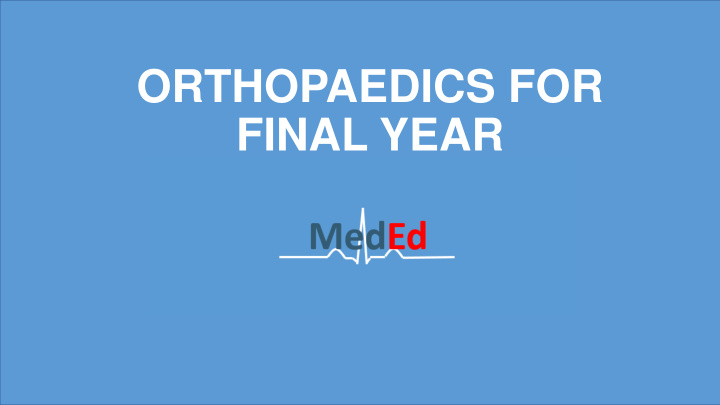



Question 1 You are working as surgical F1 at night and you are fast- bleeped to a major trauma call arriving into A&E. The A&E registrar is undertaking the primary survey and you begin to help. The patient is hypotensive. What should your next act of management be: A. Take some blood and order an FBC, U+Es, LFTs, CRP and a Lactate B. Perform a 12-lead ECG, the patient has a tachycardia C. Request Pan-CT trauma series D. Establish IV access with a wide-bore cannula and start crystalloids
THE FOUR Rs • R esuscitation • R eduction • R estriction • R ehabilitation
THE FOUR Rs • R esuscitation = A → E • R eduction = pulling on it / traction • R estriction = plates, screws, casts • R ehabilitation = physio, occupational therapy, and analgesia
Resuscitation • R esuscitation = A → E Primary Survey +/- 3-point C-Spine Immobilisation IV access, VBG, Set of bloods inc G+S for blood Crystalloids 500ml → 1L (+/- DAMAGE CONTROL SURGERY) Secondary Survey + Pan CT
Reduction • R eduction = Pull on it Requires adequate analgesia: Opioids / neural blockade / General anaesthesia Pre-hospital / Ward-based / Intra-operative Intra or post-reduction imaging May require on-going traction until intra-operative fixation is established
Restriction • R estriction = pin it / screw it / plate it / nail it Casting, usually ward-based unless reduction under GA Fixation: internal OR external monoplane OR multiplane K-wires, metal plates, cannulated screws, dynamic screw, intramedullary nails, Taylor Spatial Frame, Lizarov Apparatus
Restriction
Restriction
Rehabilitation • R ehabilitation Adequate analgesia → Allows early rehabilitation • WHO analgesic ladder +/- PPI • Complimentary analgesics Physiotherapy (graded, progressive) Occupational therapy
Trauma #NOF #Long bones Shoulder dislocations
#NOF Shortened leg Externally rotated Unable to weight-bare Tenderness over greater trochanter Discrepancy in leg length
Hip Fractures Intracapsular: • subcapital (through the junction of the head and neck) • basocervical fracture (through the base of femoral neck) Extracapsular: • intertrochanteric (between the two trochanters) • subtrochanteric (<5cm distal to the lesser trochanter)
Hip Fractures
Hip Fractures
Garden Classification 1. Incomplete #, undisplaced 2. Complete #, undisplaced 3. Complete #, partially displaced 4. Complete #, completely displaced
Management
a) Internal fixation with short gamma nail b) Internal fixation What kind with dynamic hip of fixation is screw this? c) External fixation with femoral plate + screw d) Screws to fix poorly leg
Types of Fixation
Types of Fixation Kirschner wires “K wires”
Types of Fixation
Hip Fractures Intracapsular: • Subcapital --> DHS, Cannulated screws, THA • Transcervical --> DHS, Cannulated screws, THA Extracapsular: • Intertrochanteric --> gamma nail • Subtrochanteric --> femoral nail
Types of Fixation
Hip Fractures Fracture Repair • Mal-/non-union • Osteomyelitis • AVN – YOUNG VS ELDERLY • Compartment syndrome Hip Replacement • Deep infection • VTE • Dislocation – AVOID FULL HIP FLEXION • Nerve injury: sciatic, SGN • Leg length discrepancy
THR Approaches Posterior -most common -does not violate hip abductors -higher rate of dislocations Anterolateral -violates hip abductors -lower rates of posterior dislocation
Hip Fractures
Recommend
More recommend